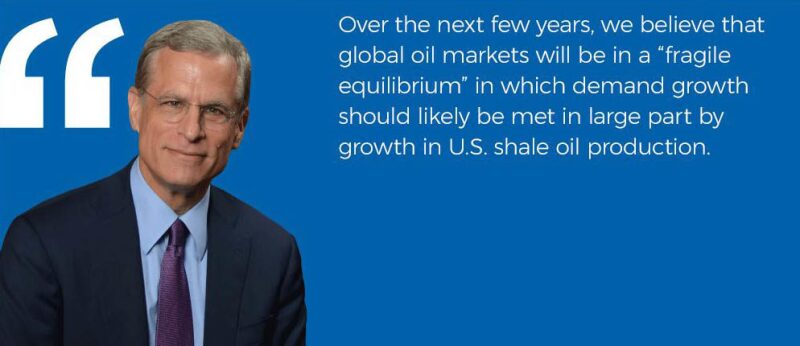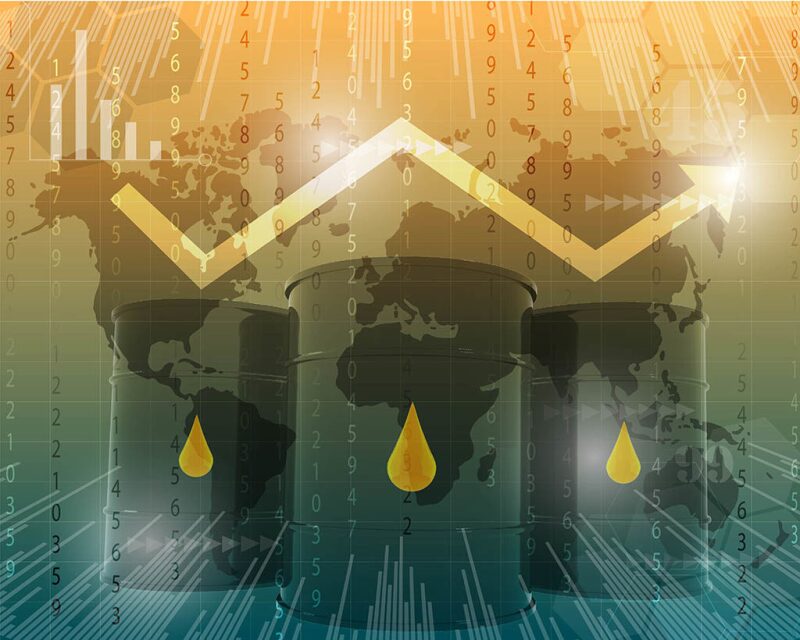
Oil prices appear to have stabilized during the past year, and speakers at the annual Energy and the Economy Conference at the Dallas Federal Reserve Bank say they expect prices to remain level, at least for a little while.
“It is our own view at the Dallas Fed,” Robert Kaplan, president and chief executive officer (CEO) of the Dallas Fed, said, “that we are roughly in global supply/demand equilibrium after having spent the last 2 or 3 years, at least up until recently, in an oversupply situation.”
This equilibrium, Kaplan continued, is not guaranteed to last. “It is also our view that, in the next few years, it is very likely that we may well get into a global undersupply situation.”
Kaplan cited the continued growth in global demand as one of the main reasons for a potential shift in the supply/demand situation. According to the International Energy Agency, demand for oil grew from an average of 90.4 million B/D in 2012 to approximately 98.4 million B/D in the first quarter of 2018. This number has been estimated to grow to approximately 101.5 million B/D by 2020, driven primarily by emerging-market economies.
“The challenge,” Kaplan said, “will be to produce enough oil to meet demand growth over the next 3 to 5 years.”
North American shale, particularly the Permian Basin, is poised to help meet that demand growth, although several factors could prove to be hurdles. “Our contacts believe that US shale production should be sufficient to supply a substantial portion of incremental global demand growth for the next few years,” Kaplan said, adding, “However, our industry contacts are concerned about key production impediments that have the potential to limit the ability of shale to supply incremental global demand growth beyond that time frame.”
The challenges include the rapid production-decline curve of shale and shortages of labor as well as environmental and infrastructure challenges.
A shift from what Kaplan called “a fragile equilibrium” to an undersupply situation could bring an increase in oil prices, but how those prices will increase is anyone’s guess.
“I think oil and gas people should never answer the question where they think oil and gas prices are going,” said Kate Richard, founder and CEO of Warwick Energy Group. “One of the reasons that I don’t think that oil and gas people should ever make a specific price prediction for a specific date is that this is a market that is highly sentiment-driven.”
Richard pointed out the unique aspect of prices in the oil industry. “What happened in 2014 was a 2% oversupply issue that triggered a 60% price decline,” she said. “In no other market does that occur. If you have a 2% oversupply in rental apartments, you don’t have a 60% decline in rent.”
Now, however, Richard said she thinks the industry is operating in microcycles. “Because of the just-in-time production ability with US shale because of how much global growth US shale represents … we ricochet more quickly and we’re in more of a microcycle environment.”
Her views on oil-price prognostication notwithstanding, Richard hazarded a guess for oil prices over the next few years: “I think that oil prices will probably range between 40 and 80 (dollars/barrel).”
Thomas Jorden, president and CEO of Cimarex Energy echoed the folly of predicting prices. “I would agree that producers should never forecast prices,” he said. “We’ve studied the futures market—we generally run our capital plan looking at the strip—and we’ve been stunned at how wrong it’s consistently been. I’ve been stunned at how so many prognosticators that are so educated … nobody predicted the huge swings we’ve seen in the last few years.”
Despite the knowledge that price predictions are frequently wrong, “We’re all horribly pathetic,” Jorden said. “We know it’s inherently unpredictable, and whenever anybody gets in front of us and talks about oil prices, we just listen intently.” All of his listening has led Jorden to say he thinks oil prices will hover in this fragile equilibrium. “I’m fairly constructive on oil long term over the next 18 months. I expect it to be somewhat flat, at or near where it is today,” he said.
Jorden went on to tout his optimism for the future of the industry, excitedly underscoring the technological advances that made the North American shale revolution possible.
“I’m tremendously optimistic,” he said. “It’s the way I’m wired. … In the year 2014, when the price collapsed, people had written us off for dead, totally written us off for dead. Certainly, around the world, the expectation was that the US producer would not survive that hostile price. And yet look what happened. Innovation that was unlike anything we’ve seen in any domestic industry in my lifetime. You know, we all want to talk about Silicon Valley and the sexy tech industry, and we should. We should be proud of that. But the US domestic producers are just as successful in innovation and entrepreneurialism and taking advantage of free markets, contract law, and property rights that we have in the United States. It’s a revolution that’s been deeply American—uniquely American—and none of us foresaw it. That’s the exciting thing about it.”
Related Read: A Perspective on Oil by R.Kaplan.


